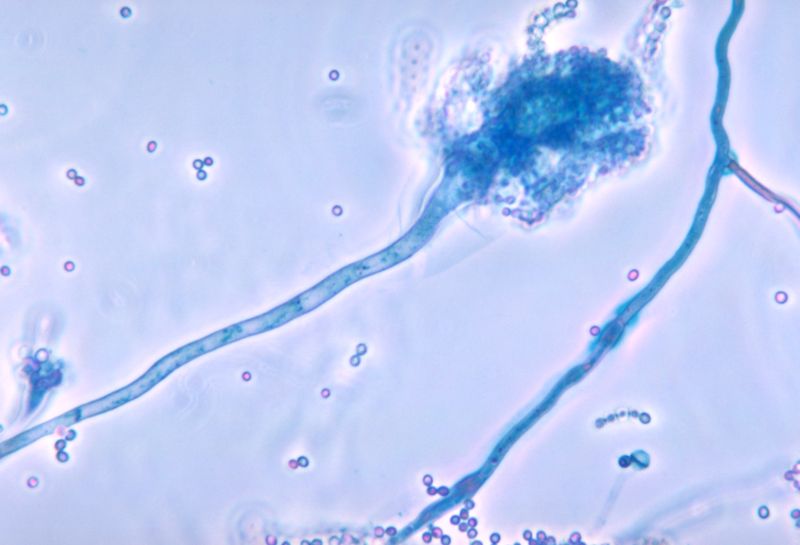Aspergillus fumigatus
|
Aspergillosis Microchapters |
|
Diagnosis |
|---|
|
Treatment |
|
Case Studies |
|
Aspergillus fumigatus On the Web |
|
American Roentgen Ray Society Images of Aspergillus fumigatus |
| Aspergillus fumigatus | ||||||||||||||
|---|---|---|---|---|---|---|---|---|---|---|---|---|---|---|
 A conidophore of A. fumigatus.
| ||||||||||||||
| Scientific classification | ||||||||||||||
| ||||||||||||||
| Binomial name | ||||||||||||||
| Aspergillus fumigatus Fresenius 1863 |
Aspergillus fumigatus is a fungus of the genus Aspergillus, and is one of the most common Aspergillus species to cause disease in immunocompromised individuals.
A. fumigatus has a stable haploid genome, with no known sexual cycle, and reproduces by forming conidiospores that are released into the environment. Capable of growth at 37°C (human body temperature), spores are common inhalation pollutants; typically, however, these are quickly eliminated by the immune system in healthy individuals.
When the fermentation broth of A. fumigatus was screened, a number of indolic alkaloids with anti-mitotic properties were discovered.[1] The compounds of interest have been of a class known as tryprostatins, with spirotryprostatin B being of special interest as an anti-cancer drug.
Pathogenesis
A. fumigatus is common in the natural environment and can also be found in the upper respiratory tracts of healthy individuals.[2] Exposure to A. fumigatus in immunocompromised individuals can lead to aspergillosis, a pulmonary infection. Leukemia or bone marrow transplant patients are at particular risk.[2] Symptoms can include fever, weakness, chest pain, unexplained weight loss, aches, a heart murmur, blood in the urine or abnormal urine color, and straight, narrow red lines of broken blood vessels under the nails. Several virulence factors had been described [3].
A. fumigatus is also the causative pathogen in stonebrood, a disease of honeybees.
Genome
The genome sequences of three Aspergillus species—A. fumigatus, A. nidulans, and A. oryzae—were published in the journal Nature in December 2005.[4],[5],[6]
See also
References
- ↑ Cui CB; et al. (1996). "Spirotryprostatin B, a novel mammalian cell cycle inhibitor produced by Aspergillus fumigatus". J. Antibiot. 49: 832–835. PMID 8823522.
- ↑ 2.0 2.1 Washington JA (1996). Principles of Diagnosis. In: Barron's Medical Microbiology (Barron S et al, eds.) (4th ed. ed.). Univ of Texas Medical Branch. (via NCBI Bookshelf) ISBN 0-9631172-1-1.
- ↑ Rementaria A; et al. (2005). "Genes and molecules involved in Aspergillus fumigatus virulence". Rev Iberoam Micol. 22 (1): 1–23. PMID 15813678.
- ↑ Galagan JE; et al. (2005). "Sequencing of Aspergillus nidulans and comparative analysis with A. fumigatus and A. oryzae". Nature. 438 (7071): 1105–15. PMID 16372000.
- ↑ Nierman WC; et al. (2005). "Genomic sequence of the pathogenic and allergenic filamentous fungus Aspergillus fumigatus". Nature. 438 (7071): 1151–6. PMID 16372009.
- ↑ Machida M; et al. (2005). "Genome sequencing and analysis of Aspergillus oryzae". Nature. 438 (7071): 1157–61. PMID 16372010.
External links
| Wikimedia Commons has media related to Aspergillus fumigatus. |
- The Aspergillus Trust A registered UK charity engaged in support of sufferers of aspergillus disease worldwide and research into cures
- The Fungal Research Trust
- Aspergillus info from DoctorFungus.org